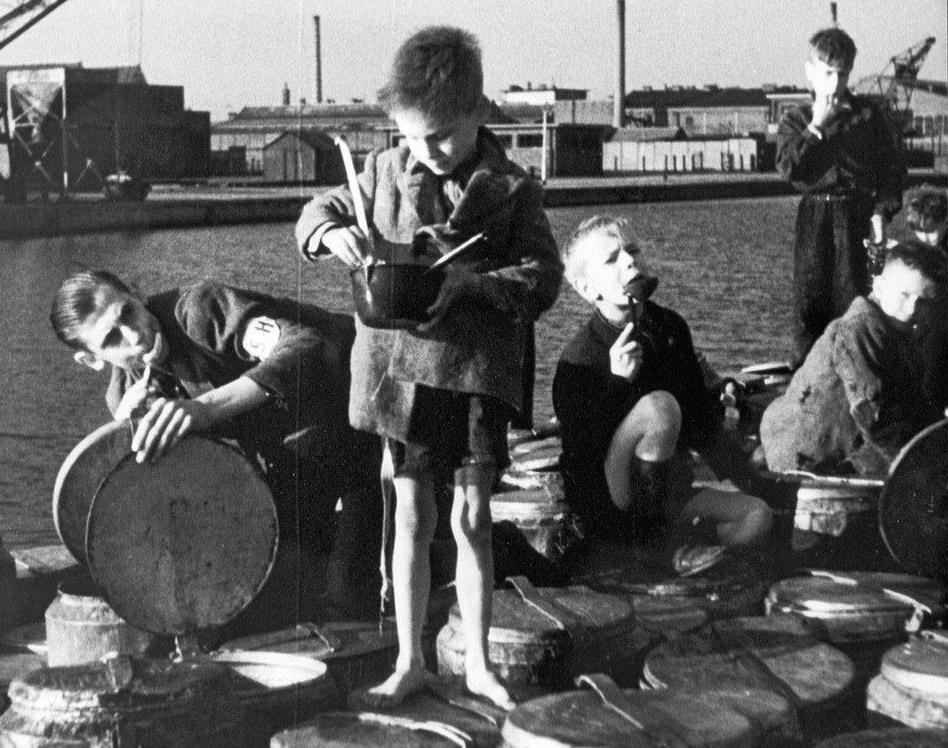
World War II: Dutch Hunger Winter / Hongerwinter --The Children and Elderly

Figure 1.-- Here we see famished Dutch children probably in Amsterdam licking what looks like food canisters of some kind or perhaps grbage can for a few morsels of food. Hopefully our Dutch readers will know what those canisters are. This would have been near the end of the War, probably April 1945.
|
|
The children and elderly were the part of the population most at risk. We see see pictires of the children scvaging in garbage. And thee two groups began to exhibit symtoms of starvation (January 1945). The underground issued pleas to the Allies, but crossing the Rhine for the allies was a huge military obstacle. Children were sent by their parents into the streets to steal food, amything they could find. Adults looking back vividly remembered eating the food that was avaiable. One woman recalls how as a girl the family survived on dried peas their nother had pridently put aside. [Collingham, pp. 176-77.] Dutch churches found accomodations for some 50,000 malnourished city children. Some 140,000 malnourished city children were evacuated to the countryside with permission from the Germans. The children were moved at night. Many moved on foot but barges were the commonest trasport when the canals were not frozen. They had to nove at night because Allied aurcraft attacked anyrhing tht moved during the day. Children took only a few precious possessions and often the clothes on their baxk. Desperate parents were willing to send their children into the countryside with the fresh air of the northern farms where at least some food was available. There are many moving stories. One source tells us about 12-year old Tineke Meijerís . She rembers standing beside the barge thatwould transport her. "Her mother was with her for a last farewell. In the distance, Tineke saw a girl approaching them with a doll in her arms, but soon realized it was a very small woman, and the doll was not a doll. The woman spoke urgently to Tinekeís mother: 'Can your daughter take the baby? We canít stay in hiding any more because she cries and makes a lot of noise.' Although Tineke said no, she didnít know how, her mother told her she could. In fact, she successfully hid the baby from the German authorities who were counting children. On the other side, someone came and took the baby out of her arms, to her confusion and somewhat to her sorrow. Itís almost like the Tomb of the Unknown; I wonder how many war children might be that child of unknown parents." [Fillmore] There are horendous images of starving children near death when the Allies finally arrived. The children generally had people lookin after them. This was not always the case for the ledely.
Sources
Collingham, Lizzie. The Taste of War: World War II and the Battle for Food (Penguin Books: New York, 1962), 634p.
Fillmore, Mary Dingee. "Saving hungry Dutch kids in 1945, Hidden Amsterdam (March 19, 1945).
CIH

Navigate the CIH World War II Pages:
[Return to Main Dutch Hunger Wnter page]
[Return to Main liberation of the Netherlands page]
[Return to Main World War II famine page]
[Return to Main German war crimes page]
[Biographies]
[Campaigns]
[Children]
[Countries]
[Deciding factors]
[Diplomacy]
[Geo-political crisis]
[Economics]
[Home front]
[Intelligence]
[POWs]
[Resistance]
[Race]
[Refugees]
[Technology]
[Bibliographies]
[Contributions]
[FAQs]
[Images]
[Links]
[Registration]
[Tools]
[Return to Main World War II page]
[Return to Main war essay page]
Created: 2:09 PM 5/19/2017
Last updated: 2:09 PM 5/19/2017



